

|
High Resolution Log contains the online data for a long period of time (e.g. years). By default, values are sampled once per second. However, if required, this sampling rate can be increased. For more information, see Configuring values sampling rate for the High Resolution Log in the Data Set Setup dialog further in this section.
The whole High Resolution Log functionality includes the following:
Therefore, SCADA High Resolution Log is especially useful for viewing and analyzing physical parameters with frequently changing values (e.g. electrical signals, wind speed, active/reactive power, etc.).
As soon as you reach the Operational Logs toolbar, you can take all the necessary steps for successful generation of the High Resolution Log in MiScout SCADA Desk.
1. Click the New icon available in the Window section of the toolbar to open the Operational Logs Browser window.
2. Afterwards, select the appropriate controller in the Controller View panel to the left of the main window.

3. Next, click Vendor or SCADA icon in the High Resolution Log section on the main toolbar.
As a result, the Communication Log will show appropriate messages ensuring that communication with the selected controller has been established. Besides, the Channels panel will appear to the right displaying a list of channels available for this log type.
4. Specify required channels you'd like to see in the log by selecting corresponding check-boxes.
Note. Prior configuration of the data item is required to have it presented on the Channels list in the High Resolution Log window. For more information on configuring the data items properties for generating SCADA logs, refer to Data Sets Setup section (SCADA properties).
Configuring values sampling rate for the High Resolution Log can be easily made in the Data Set Setup dialog. To do this, simply enter a new value in the Refresh time (ms) property field and press OK. For more detail information on configuring data set properties, refer to Data Sets Setup section.
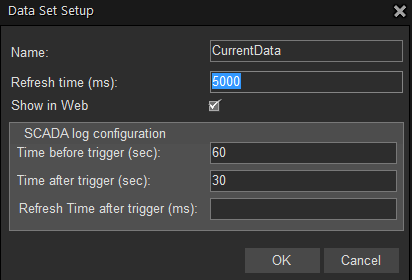
Additionally, Filter mask can be used for a comfortable and quick search for the required channels based on the channel name. To view the selected channels, select the Checked Only check-box.
5. To proceed, specify the time period for the log to be generated using desirable tools provided by the Time selector.
6. Eventually, press the Start button to launch the log generation process.
Finally, the log data will be shown in Operational Log Browser.
Generally speaking, logs display graphical or numerical presentation of the selected parameters over a definite time period, which a user has prior specified. The logs data can be presented in two modes - as a Chart and Grid. You can easily switch between the data presentation modes by clicking the corresponding icons.

In the meantime, Chart is used as a default mode. Therefore, as soon as the log is ready, the Data window in the Chart view appears giving a graphical presentation of the High Resolution Log data.
To the right of the log chart you can see all the channels, based on which the log is generated. As you can see, part of the channels are grouped together. For more detail instructions on channels grouping, refer to Configuring data item general properties described in the Data Sets Setup section.
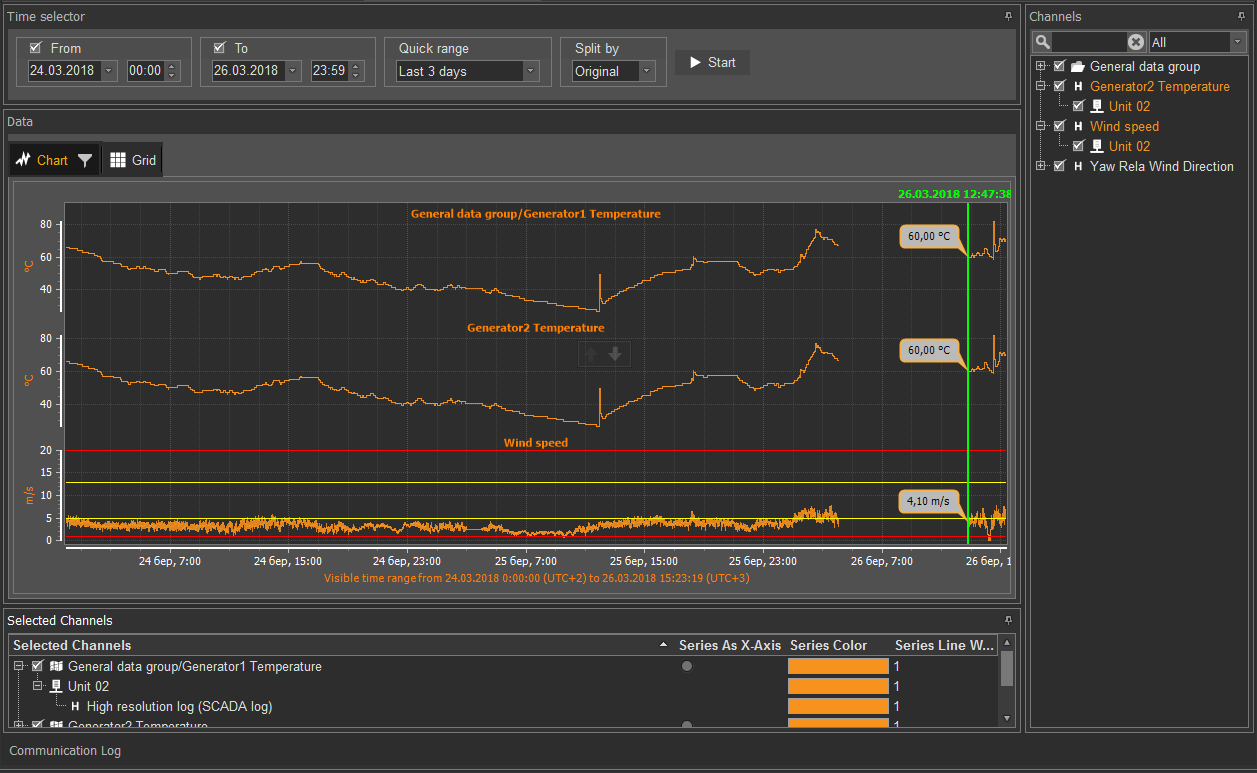
The Selected Channels section provides a possibility to customize the Chart appearance. You can adjust the desired look by setting the following parameters:
The Series as X-axis option switches the chart to the scatter plot mode allowing to see the dependency of one channel on another one. (e.g. of power on wind speed).
To zoom in the required part of the graph make a selection with the cursor in the direction from the left to the right, and zoom in several times thus enlarging the picture more and more. To zoom out, you should make a selection in the opposite direction - from the right to the left. Zooming out is performed just once and returns the window view to its original scale.
Note. Channel lower/upper values to specify the threshold range must be preliminary configured in data mapping. For more information, see custom mapping in the Data Class Editor section.
High Resolution log in a Grid view presents numerical data for selected channels and controllers. The Grid consists of several columns depending on the quantity of the selected Channels as well as parameters selected in the Show/Hide section. The first column Timestamp displays date and time, whereas rest columns contain data according to the selected channels.
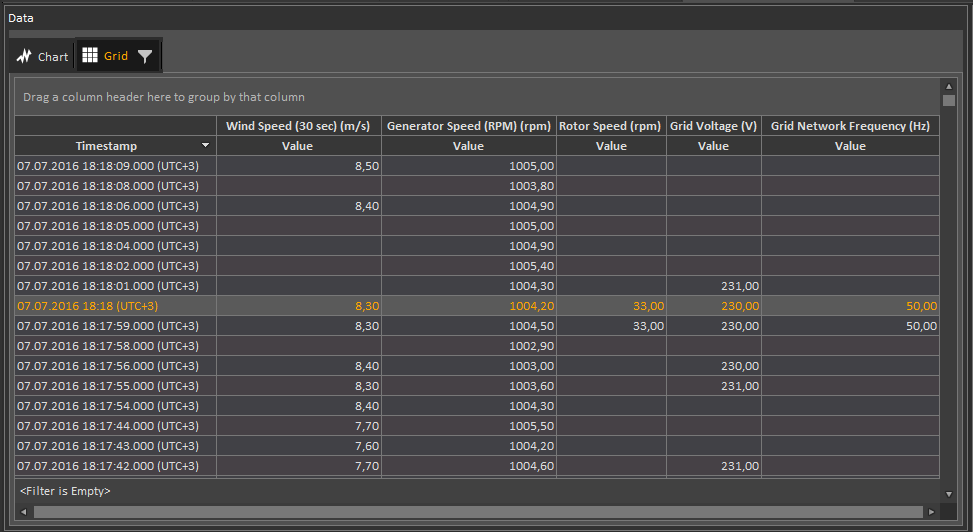
Each channel in the grid may contain 4 columns named Avg, Max, Min, Dev sub-columns depending on Show Span and Show Deviation settings as well as data available on the controller. The second and the third columns present information on maximum and minimum parameter values respectively over the specified time range; while the first column gives parameter's value averaged over that time range; whereas the fourth column displays the deviation value.
The channels in each column can be sorted by name or by values in a descending or ascending order by pressing the column caption. As soon as you click the column caption, a gray downward or upward arrow icon appears. Therefore, after pressing the downward arrow icon, values in the selected column will be sorted in a descending order; whereas on pressing the upward arrow icon, values in the selected column will be sorted in an ascending order.
Besides, MiScout Desk allows to filter channels in each columns of the grid using the  filter icon found next to the column name. So, all you need, is to select the required options in the revealed drop-down menu.
filter icon found next to the column name. So, all you need, is to select the required options in the revealed drop-down menu.
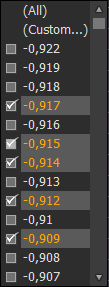
You can also configure a grid filter by clicking the Customize...
 icon.
icon.
Upon clicking the  Filter icon you can easily customize the process of filtering by setting the required parameters and conditions.
Filter icon you can easily customize the process of filtering by setting the required parameters and conditions.
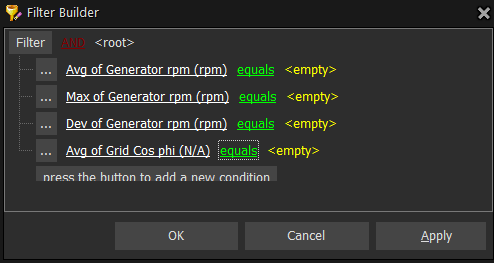
In case High Resolution Log presents data on the same channel for a number of different units (i.e. controllers), they are represented by a different color on the chart. This is vividly demonstrated on the screen bellow.
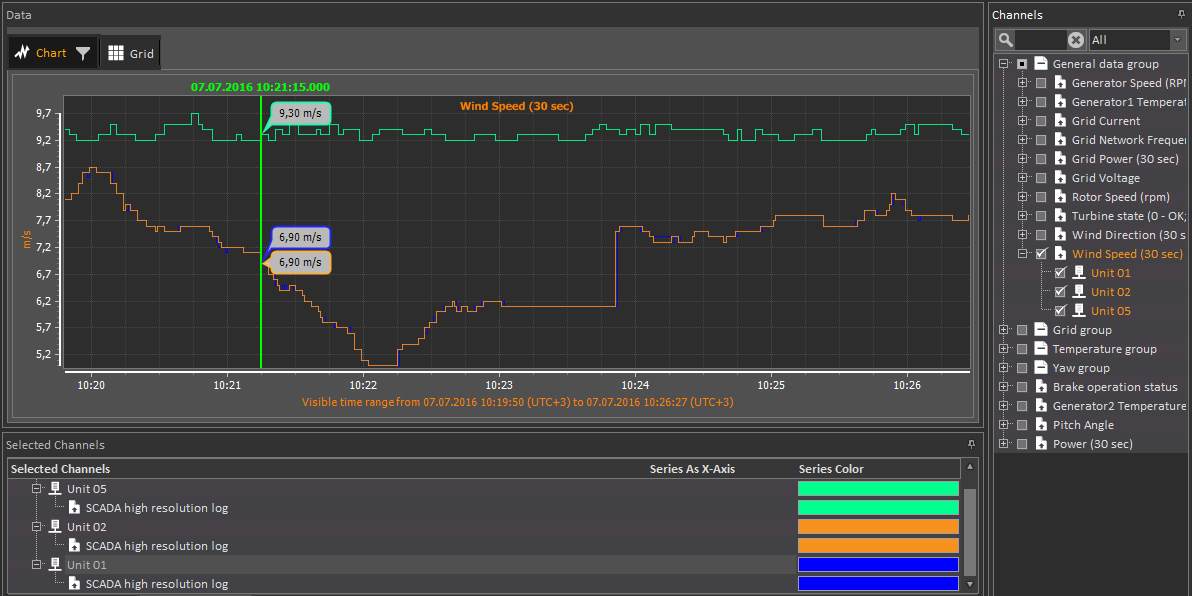
On switching the log to the Grid view, the same colors are used to denote values for different controllers.
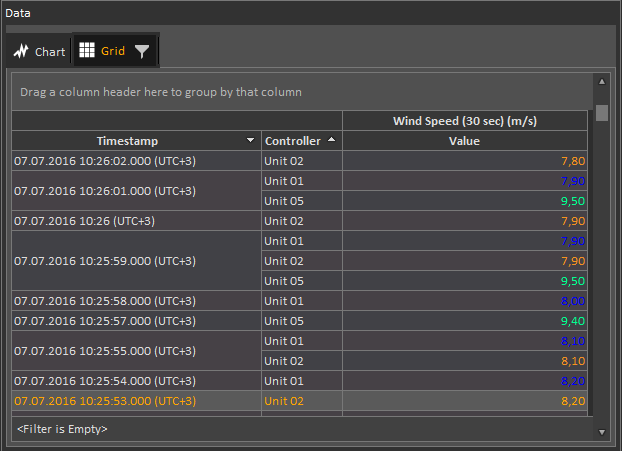
Viewing and saving log data as an Excel (.xls) file
For user's convenience, all controller data shown in the Operational Logs Browser can be viewed and saved as an Excel (.xls) file. For more detail instructions, refer to Viewing and saving log data as an Excel (.xls) file described in Vendor Standard Average Log.